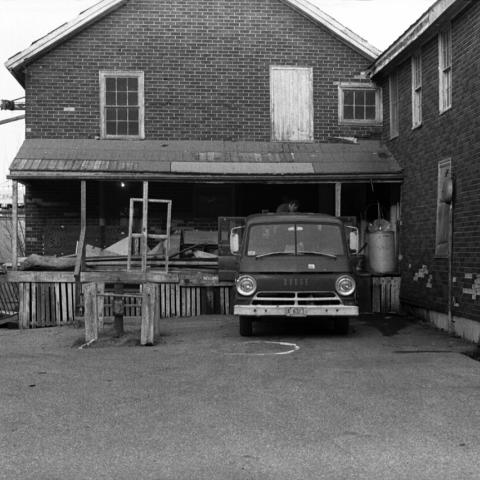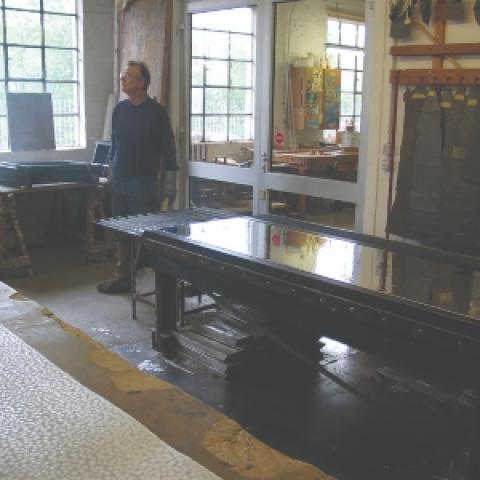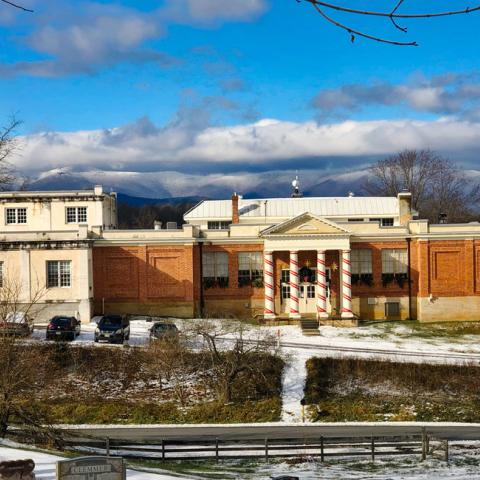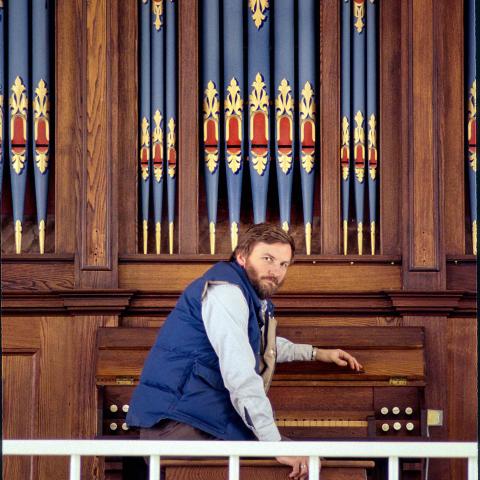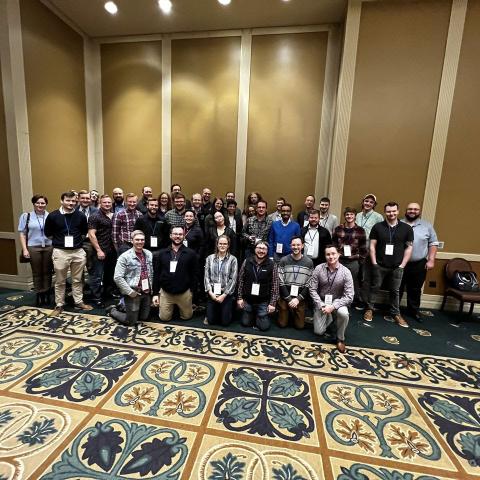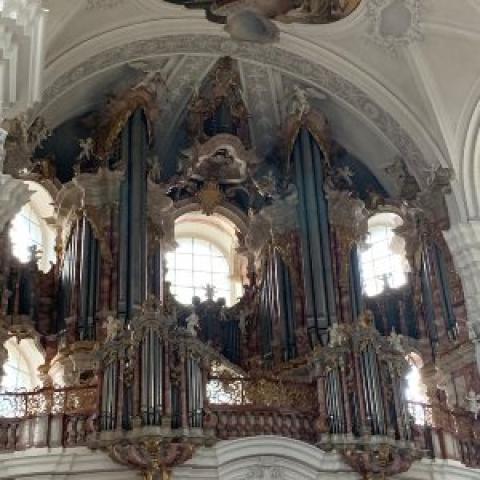Fire in the steeple
Writing for a monthly journal is no place to be commenting on today’s news. A momentous story will develop during the six weeks between submission and publication leaving the telling of the event, which seems so fresh and urgent at the moment of writing, little more than a heap of yesterday’s news.
Today is April 17, 2019. Two days ago, the world watched in horror as Notre-Dame de Paris burned. Dramatic photos in the hundreds were provided by still photographers, television cameras, helicopters, and fire department drones. We all speculated as to the extent of the damage. One aerial photo convinced me that the great Cavaillé-Coll organ at the west end of the cathedral was ablaze.
Yesterday we learned with relief that most of the stone fabric of the great church remained intact and that many priceless artifacts had been whisked out of the building by heroic firefighters forming a bucket brigade. And to the joy and relief of the world’s community of organists, both organs remained intact. As of today, it seems that the Choir Organ suffered significant water damage but can be restored. But miraculously, the Great Organ stood above the fray. It is nestled between the two towers like a brute in a too-tight sport jacket, and it is under a pitched roof that is lower than the main roof that was destroyed. The heat of the fire, which we might have expected would reduce the brilliant instrument to a puddle of molten lead, dissipated into the night air far above the organ.
By the time you read this, we may know the cause of the fire and the actual condition of the building and its contents. I hope the blame does not get pinned on one person. Perhaps the organ and rose windows will have already been removed to safe storage, and committees of engineers, historians, and artisans with impressive credentials will have been formed to plan how to spend the billions of euros that have accrued. While I am tempted to write lots of detail of what I know or think I know from the safety of New York City, I think I will sit back and wait with the rest of you to know the situation as of the first of June.
Many of the stories I have read and heard have spoken of the integrity of the 850-year-old building. The medieval architects and craftsmen who built it had such foresight and skill. Could they have imagined that their work would be robust enough to sustain such an event so far in the future?
In 1973, David Macaulay published Cathedral (Houghton Mifflin), a delightful romp through the construction of a fictional medieval cathedral told in prose and dozens of intricate pen-and-ink drawings. It is technically a children’s book—it won the Caldecott Medal that celebrates illustrated books for children—but any adult will enjoy and learn from this spirited book. The author introduces you to the workers who built the cathedral, the tools they used, how they gathered the vast bulk of materials, and the methods of construction. He describes and draws the huge wheel, similar to what you would find in a gerbil’s cage but large enough for two men to walk inside in an endless loop, coiling the rope that lifts fabulously heavy stones hundreds of feet.
Central to the structure of any Gothic cathedral, whether ancient and modern, is the system of flying buttresses (repeatedly called “trusses” by a CNN commentator) and vaulted stone ceilings that counteract each other to hold the whole thing up in an exquisite demonstration of engineered balance. That balance is essential to allowing the high walls to be perforated by enormous windows. The combination of the soaring fluted columns and the windows letting sunlight in through acres of stained glass gives an impression of weightlessness to a structure that weighs thousands of tons. Anyone who has wandered into a great cathedral and had their gaze drawn upward deserves a read through this vivid description of how in the world such a thing could be accomplished when the only available industrial power was supplied by mammals.
David Macaulay’s Cathedral is available through your favorite independent bookstore, or if you must, amazon.com.
Medieval cathedrals, old and new
Three years ago, Wendy and I had a wonderful trip to Great Britain. She attended the London Book Fair for a few days while I explored London’s ecclesiastical buildings and their organs. I also found a gobsmacking whole hog roast at Borough Market adjacent to Southwark Cathedral and had a life-altering sandwich. “Do you want crispies on that, mate?” We took the train to Durham, where I had invited myself for a visit at the workshops of Harrison and Harrison and where we stayed in a rickety bed and breakfast above an ancient pub called the Victoria Inn. I picked up a rental car the next morning (shifting gears with my left hand) and mentioned where we had stayed to the clerk. “Oh, the Old Vic. You take your life in your hands when you go in there.”
A friend from the Harrison & Harrison workshop gave us a splendid visit to the organ at Durham Cathedral (why have one 16′ Double Open Wood when you can have two, one on each side of the choir, one of which goes all the way down to 32′ low CCCC?), and we drove to York. This time we stayed at a very swank inn with views of York Minster from our room, and after a ponderous “Full English Breakfast,” we toured the Minster. Durham Cathedral is really old as medieval cathedrals go, built between 1093 and 1133, and its stone fabric is dense and heavy. I have not done a lot of research, but I assume that it was built before flying buttresses were invented, because instead of that lacy weight-defying tracery, Durham Cathedral is built with some of the thickest stonewalls in Christendom. Even the windows seem load bearing. It holds itself up by sheer bulk. By contrast York Minster, started in 1220 and completed in the full glory of the high Gothic, sports huge windows, a magnificent vaulted ceiling, and the elaborate system of buttresses that help such massive buildings seem weightless.
What a terrific place. York is one of the really big ones, a hundred feet longer inside than Durham Cathedral and twenty-five feet higher. Although the sky was overcast during our visit, the building seemed light and airy inside. The organ sits high on the screen that separates the choir from the nave, commanding both the east and west views, and its 32′ Diapason, metal this time, stands in full-length splendor in the ambulatory. It is disguised with circular ridges of some kind of putty and painted to resemble the lofty stone columns. Incredible.
There was no sign, no informational kiosk, and no trace of the fire that ravaged York Minster in July of 1984. The wood structure of the roof burned in similar fashion to this week’s fire in Paris. Firefighters contained the blaze to the transept by intentionally collapsing the roof with tens of thousands of gallons of water. The investigation that followed suggested that the fire was likely caused by a lightning strike, but there was at least some chance it was caused either by arson or an electrical fault. Conservative Anglicans supposed that the fire was God’s response to the recent consecration of David Jenkins as Bishop of Durham, with whose policies and philosophies they vehemently disagreed. ’Twas ever thus . . . .
The good news is that the damage was fully repaired. That triumph of recovery has been cited as a potent example proving the possibility and feasibility of returning Notre-Dame de Paris to its original condition.
A modern historic organ
John Brombaugh installed his Opus 4 in the First Evangelical Lutheran Church in Lorain, Ohio, in 1970. Professor of organ at Oberlin David Boe, then in his twenties, was organist at the church and had much to do with the creation of that remarkable instrument. As one of the first modern instruments built in the United States using ancient European principles and given its proximity to the teeming community of budding organists at Oberlin, that organ caused quite a sensation and was revered by countless musicians as a milestone of the art. The Organ Historical Society awarded the instrument a historic citation, one of the few occasions when the OHS has honored a modern instrument for its historical importance.
On August 28, 2014, the church building and its contents were destroyed by an arsonist. A new building was completed in 2017, and a new organ by Paul Fritts & Company will be installed later this year.
A couple weeks ago, my colleague Amory Atkins and I were in Seattle installing an organ at the School of Music of the University of Washington, and we took the opportunity of proximity to take a field trip to Tacoma to visit Paul Fritts’s workshop. It was Amory’s birthday, and it was fun to have a reunion with friends there as we had all worked together on a large project, a couple years earlier, and Bruce Shull (who works there) and his wife Shari were my pals at Oberlin in the 1970s. We saw the beautiful new instrument for First Lutheran in Lorain, pretty much complete and playable in the workshop. It was poignant to note how far the concept of the modern American tracker-action organ has come in the past fifty years.
Organs built by Paul Fritts are elegant, expressive, and impressive, and the craftsmanship is impeccable. Complex joints and multifaceted moldings are brilliantly accomplished. Embossed polished façade pipes gleamed in the late afternoon sun.
The Fritts workshop sports a tantalizing juxtaposition of modern and ancient techniques. A sophisticated CNC (Computer Numeric Control) router the size of a small bus lurked in a separate building, exiled along with its specialist operator from the peace and tranquility of the rest of the workshop. It is capable of converting digital drawings into finished wood projects from windlines with complex miters to reed boots with compound tapers. Another room houses the centuries-old technology of a melting pot and casting table, where metal becomes liquid and is cast into sheets from which the parts of organ pipes are cut. Paul shared that casting sheets on sand rather than cloth or marble produces metal with a crystalline structure that springs to life under the hands of the voicer like none other. Once the sheets are cast, they are hammered to increase their density and planed smooth. While the casting table is the same technology shown in eighteenth-century prints like those by the good monk Dom Bédos, the metal hammer and drum plane are monster industrial products of the modern age.
First Lutheran in Lorain has built a new building on a new plot of land. Visit their website, www.firstlutheranlorain.org, to see photos of the new building, photos, specs, and history of the Brombaugh organ, and photos of the new Fritts organ. It is a great example of the phoenix, rising from the ashes.
The death of an old friend
In 1984, I went to work for Angerstein & Associates in Stoughton, Massachusetts, where one of my responsibilities was to participate in the firm’s active organ maintenance business. One of the organs I visited regularly from the beginning was the twenty-rank instrument built in 1872 by E. & G. G. Hook & Hastings (Opus 635) for the First Baptist Church of Wakefield, Massachusetts. Three years after I joined Angerstein & Associates, the owner Dan Angerstein closed the business to accept the position of tonal director at M. P. Möller. That turned out to be a short-term appointment as Möller closed its doors a few years later, but it was a great opportunity for me to take on Dan’s maintenance contracts and start my own company.
About three years after that, I moved the Bishop Organ Company into a sunny building in an industrial neighborhood in Wakefield, just blocks from the Baptist Church. There is a two-mile-long lake right in the center of town, and one of my employees had grown up in the little sailing club on its western shore. It did not take long for me to get involved there, to buy a boat from him, and start my sailing career in earnest. I helped start a junior sailing program, teaching children how to sail; my son Michael became an earnest competitor in the club’s weekly races, and I was elected commodore. Michael and I share the passion for sailing today thanks to our years in Wakefield.
I enjoyed the proximity of the workshop to the Baptist Church and occasionally went there to practice, just for the pleasure of playing on that beautiful historic organ. Along the way, the leather gussets and canvas hinges on the huge double-rise reservoir failed, and my crew and I removed the wildly heavy assembly to the workshop, including two feeder bellows, stripped off all the old material, and restored it to original reliable working condition.
The First Baptist Church fit the stereotype of the quintessential New England Protestant church. Its soaring spire dominated the landscape of the town, and its grand 800-seat sanctuary was as large a room as one might imagine being built with a wood frame and no supporting columns inside. The way the structure of the building worked was that the ceiling and walls were suspended by the steeply pitched superstructure that supported the roof, another ingenious approach to building large structures that defy their own weight.
There was a second pipe organ in the chapel downstairs, a one-manual tracker built in the 1970s by the Andover Organ Company, just like the instrument that had been owned by Daniel Pinkham and used in his famous recording of Antonio Soler’s concertos for two organs. The other organist on that recording was the brilliant E. Power Biggs playing “his” Flentrop organ in Harvard University’s Busch Hall, formerly known as the Busch-Reisinger Museum. The chapel was decorated with ornate oak carvings including pews, chancel furnishings, and an elaborate screen, all relocated from a downstairs worship space at Boston University’s Marsh Chapel.
For more than thirty years I made maintenance visits to the organ, knowing all along that it was the home church of my colleague and friend John Boody, principal at Taylor & Boody Organbuilders. John’s grandfather had been pastor of the church. Often during one of those visits, I would send John a photo of the organ just to say hello, and we talked fondly about it whenever we met. The church’s pastor (it was the same guy for more than thirty years) had a big candy habit, and we knew we could expect him to provide little baskets or bags fit for the season. Once I went there to tune during Holy Week and found the pastor sporting a Crucifixion necktie, complete with images of three crosses with an “Elvis on black velvet style” sunset. Hope I never see another like it.
In the evening of Tuesday, October 23, 2018, the spire was struck by lightning, and the building burned. A portion of the front wall facing the street was all that remained. The church’s safe, jam-packed with 150 years of historic documents, fell through four stories of burning floors into six feet of water. Both organs were incinerated. The E. & G. G. Hook & Hastings organ, built by some of history’s finest organbuilders, inspiration for one of the finest of twentieth-century American organbuilders, present for more than 7,500 Sunday mornings and countless weddings and funerals, 146-years-old and still going strong . . . gone.
Photo caption: First Baptist Church, Wakefield, Massachusetts, 1872 E & G. G. Hook Opus 635 (photo credit: John Bishop)

